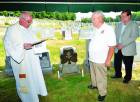


For more than 50 years, the man once known as “Yonkers Favorite” lay in an unmarked grave in the St. Jude section of St. Joseph’s Cemetery there.
That oversight was rectified on a steaming hot afternoon July 22 when the descendents and friends of Michael J. Hogan, also known in his time as Shamus O’Brien, gathered with local dignitaries, including Yonkers Mayor Philip Amicone and State Assemblyman Mike Spano, to dedicate a new headstone of rose-colored granite in the form of a shamrock to a former lightweight boxing champion. A Celtic cross and a pair of boxing gloves engraved on the facing concisely conveys who is buried beneath.
For William F. Torpey, grandson of the bare-knuckled boxer, once the toast of Yonkers and winner of the county lightweight championship in 1911-1912, it was the culmination of a long personal quest to ensure his grandfather was memorialized in proper fashion.
“When I learned that he was here in the cemetery and I found that he had no stone and no marker, no anything, I was kind of devastated,” Torpey said. “So I wrote to the (Dr. Theodore A.) Atlas Foundation of Staten Island and they said they would provide a tombstone for him.” The Atlas Foundation worked with Ring 8 of the Veteran Boxers Association of New York and Artists Memorial Monuments of Staten Island to acquire the tombstone and it was recently installed at the top of a gentle incline. Friends and family gathered on the hottest day of the year for a brief dedication ceremony presided over by Father George J. Kuhn, pastor of St. Joseph’s parish.
“He was great boxer. He fought well over 100 matches all over this area and quite a bit of the country,” Torpey told CNY, “He fought all the champions, the best boxers of his day, Benny Leonard, Mickey Walker. He didn’t have a great record but he was a very tough boxer.”
Born in Dungarvan, County Waterford, Ireland, Hogan came to Yonkers when he was 15. He fought his first fight in a boxing exhibition at notorious Sing Sing prison. He was known as a very difficult man to put down. That toughness, win or lose, soon made him a local favorite and earned him bouts against top contenders. As his 18-year career in boxing advanced, he gained a reputation as a formidable “trial horse” opponent for promising young boxers. Before retiring in 1928 he returned to his native Ireland to win the lightweight title there. Hogan died in 1959 of pneumonia; he was 68.
Torpey, born in 1935, never saw his grandfather fight. His memories of him are more of a grandfatherly nature.
“He would take me to Nedicks and buy me an orange drink or a hot dog,” Torpey recalled. “At the time he was long separated from my grandmother whom I lived with about eight years. I was too young to talk about adult things. I was 10 or 12 at that time, so that’s how I knew him.”
Among the guests at the dedication was Hogan’s great-great grandson, John Hogan IV, a young boxer who trains under the auspices of the Yonkers Police Athletic League. Hogan, 24, with a 9-2 record, has his sites set firmly on the Golden Gloves and he believes that his relative’s spirit is with him every time he enters the ring.
“I believe that the spirit can live through other family members and can live though future generations,” he explained. “And I think that some of him is living through me. I’ve got his fighting spirit.”
Torpey can see another resemblance between his grandfather and his young cousin. “You look at his face,” said Torpey with evident pride. “If Shamus was that age, you’d say it was him.”